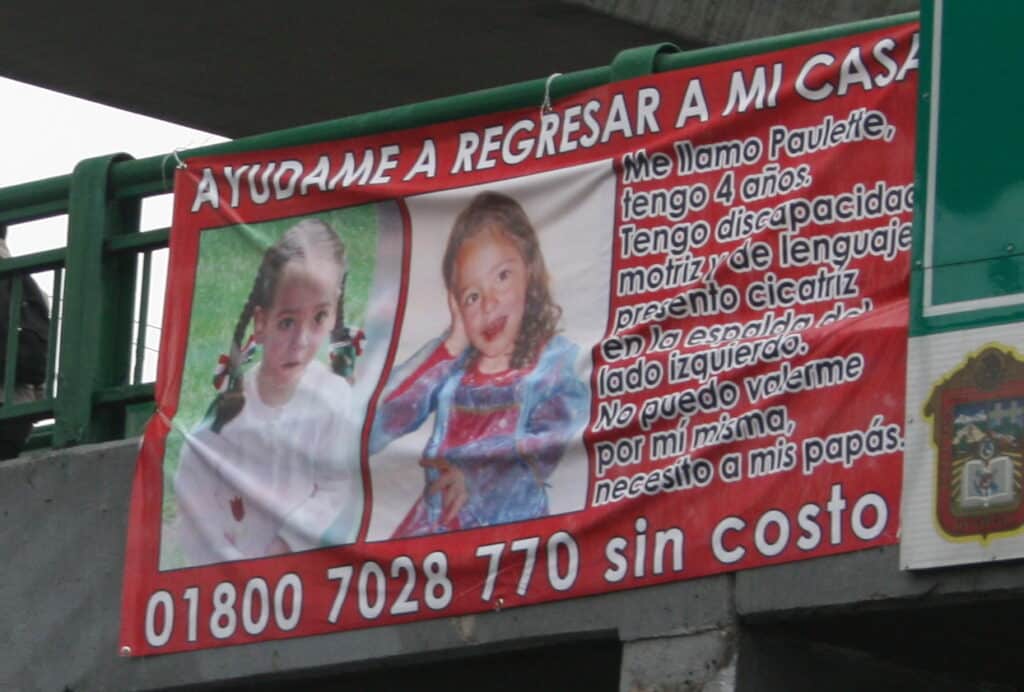In 2010, four-year-old Paulette Gebara Farah vanished from her family’s apartment in Huixquilucan, Mexico, setting off a search that gripped the country. She’d returned home the night of March 21 with her father and sister after a weekend trip. Her mother, Lizette Farah, tucked the girls into bed, and by morning Paulette was gone. The nanny who came to wake her found an empty bed and a home that showed no sign of forced entry. Doors and windows were locked, security cameras showed no one leaving with a child, and because Paulette had mobility and speech disabilities, the idea that she slipped out on her own seemed unlikely.
Police were called immediately. What followed was a sweeping effort: investigators and volunteers combed neighborhoods, highways, and nearby wooded areas; posters appeared across the city; and social media campaigns tried to keep her face and name in public view. Paulette’s parents made emotional television appearances pleading for her safe return. Her mother funded flyers, billboards, and ads on buses and TV; her father urged anyone with information to come forward.
As days passed without answers, doubts began to circle. A week into the search, authorities said inconsistencies in statements from both parents and the two nannies made it difficult to understand what had happened. All four were placed under a restriction order and moved to a hotel under police supervision while investigators went back to the apartment to reconstruct the night in question.
Nine days after Paulette disappeared, the case took a shocking turn. Investigators found her body in her own bedroom, wedged in the narrow space between the mattress and the bed frame—a place no one had checked. It was the very bed where her mother had sat for televised interviews asking for help. A leaked video from the investigation captured someone at the scene speculating about injuries, but the Attorney General swiftly announced a different conclusion: Paulette’s death was accidental, the result of “mechanical asphyxia” from nasal obstruction and compression of her torso.
The autopsy details fed that narrative. Paulette reportedly slept with an orthopedic cloth over her mouth to keep it closed; examiners said her body had not been moved after death and found that she’d eaten about five hours earlier. There were minor bruises on an elbow and a knee but no signs of sexual or physical abuse, and toxicology screens were negative. Authorities concluded she had slipped down into the gap at the foot of the bed and suffocated, somehow going unnoticed for nine days despite repeated searches.
That explanation did little to settle public skepticism. A recording emerged of a conversation between Lizette Farah and her own mother in which Farah appeared to be advised not to reveal anything that could invite blame. Farah first said the audio was manipulated, then acknowledged the conversation but insisted the context had been distorted. Officials maintained there was no kidnapping and that the death was accidental, yet many found the idea that a child’s body could evade discovery in a small, heavily searched room implausible.
Paulette’s nannies, Ericka and Martha Casimiro, were adamant that the child had not been under the mattress when they searched. They recounted looking in the bathroom, under the bed, in closets, and in other bedrooms more than once, saying the bed was made and nothing seemed amiss despite the number of people who had gone through the room. Political voices joined the criticism: opposition leader Jesús Ortega questioned how roughly a hundred police officers and sniffer dogs could have missed a body in a 10-meter room, and asked pointedly who might be protected by such a failure.
Paulette was buried on April 6, 2010, at Panteón Francés de San Joaquín in Mexico City. Seven years later, her remains were exhumed and cremated after authorities determined they were no longer needed as evidence. The official account remains that of a tragic accident, but for many, the case still raises painful, unresolved questions about what happened inside that bedroom and how an entire nation’s search failed to find a little girl lying inches from where she had last been seen.







